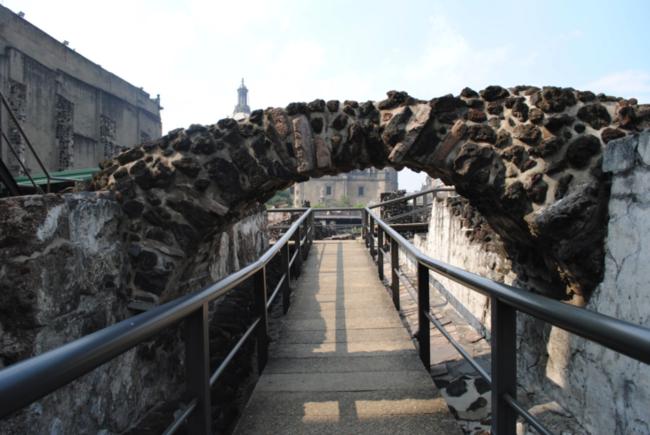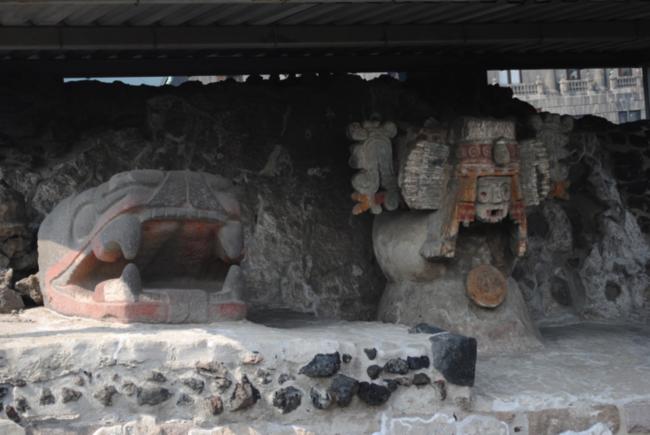
-

Colector de agua
Bajo el andador metálico corre un ducto hecho de ladrillos. Se trata de un colector de aguas, construido hacia el año 1900 que cruza bajo la actual calle de Guatemala. Al realizar esta obra pública, el Templo Mayor fue atravesado y destruidas todas las etapas constructivas en un ancho de dos metros. En esta época se pensaba que el Templo Mayor estaba sepultado bajo la Catedral Metropolitana.
-

Braseros de Tláloc
El dios de la lluvia, Tláloc, fue venerado desde tiempos muy antiguos. Era una deidad relacionada con la vida y la muerte que podía traer las lluvias y con ellas los alimentos, o por el contrario, podía ocasionar la muerte de las cosechas y de algunos individuos. Aquellos que morían por el agua iban al Tlalocan, morada de este dios. Los braseros ubicados en la plataforma de la Etapa IV, están decorados con el rostro de Tláloc. Podemos reconocer en ellos los ojos redondos y los largos colmillos que caracterizan a la deidad. El complicado adorno de su cabeza representa un tocado de papel plegado y una diadema de chalchihuites o piedras verdes, coronada con plumas blancas. Los dos adornos azules esculpidos a los lados del tocado parecen representar las nubes que guardan la lluvia que el dios hace caer sobre la tierra.
Etapa IV y V
Estructura
Stage V corresponds to the government of Tízoc, seventh Mexica ruler. Under his mandate, the building was enlarged between 1481 and 1486; the only witness that remains of the temple is a part of the platform, which survived the Spanish destruction. During the Viceroyalty, an arch was built directly over the platform and for its construction the Spaniards reused the stones of the ancient pyramids.
Water collector: Under the metallic walkway runs a duct made of bricks. It is a water collector, built around 1900 that crosses under the current Guatemala Street. When this public work was carried out, the Templo Mayor was crossed and all the construction stages were destroyed in a width of two meters. At that time it was thought that the Templo Mayor was buried under the Metropolitan Cathedral.
Braseros de Tláloc: The god of rain, Tláloc, was venerated since ancient times. He was a deity related to life and death who could bring the rains and with them food, or on the contrary, could cause the death of crops and some individuals. Those who died from the water went to Tlalocan, the abode of this god. The braziers located on the Stage IV platform are decorated with the face of Tlalocan. We can recognize in them the round eyes and long fangs that characterize the deity. The complicated adornment of his head represents a folded paper headdress and a diadem of chalchihuites or green stones, crowned with white feathers. The two blue ornaments sculpted on the sides of the headdress seem to represent the clouds that hold the rain that the god makes fall on the earth.

